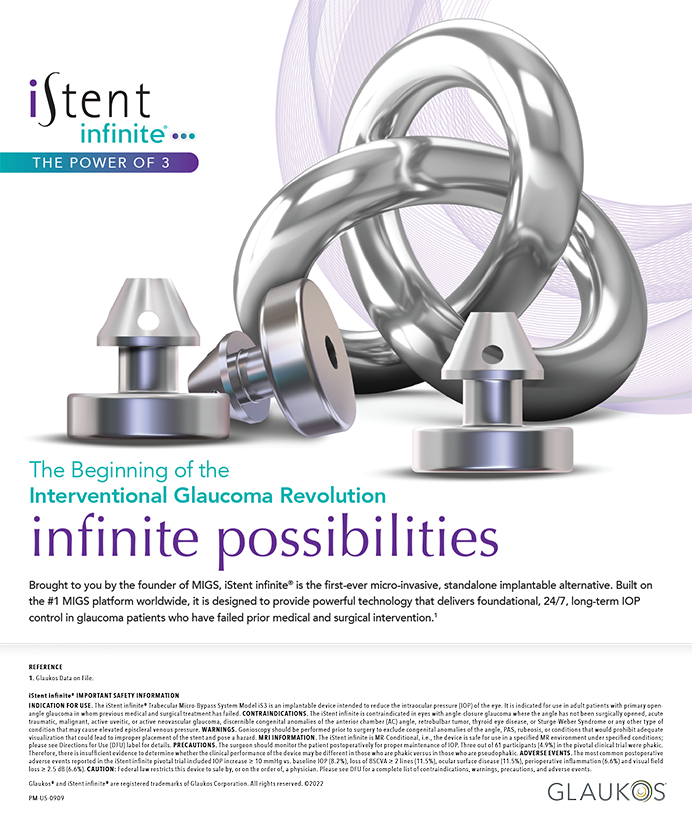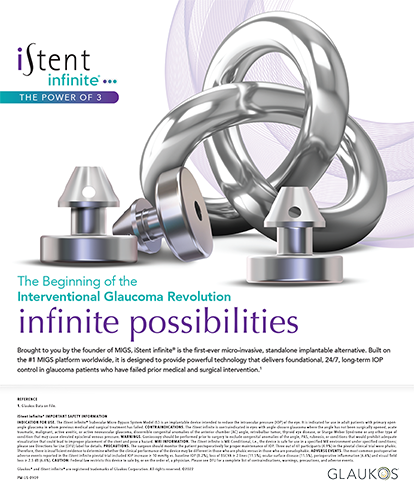CASE PRESENTATION
A 38-year-old white male presents for a refractive surgery evaluation. His past medical and family history are negative. His past ocular history includes the current use of daily soft contact lenses in which he neither sleeps nor swims. His examination is remarkable for a bilateral UCVA of counts fingers and a BSCVA of 20/15 OU. His manifest and cycloplegic refraction is -10.50 D sphere in each eye. The external, slit-lamp, and dilated fundus examinations are normal, as are his pupils, confrontation fields, motility, and tonometry readings. Central pachymetry measures 575 µm OD and 580 µm OS. Corneal topography reveals low-magnitude, symmetrical bowtie astigmatism. Keratometry (K) readings are 40.25/39.75 in his right eye and 39.75/39.50 in his left eye.
The patient is interested in a corneal refractive procedure. Would you perform PRK or LASIK? Why or why not? Is there any merit to the argument that flat postoperative keratometry results in optical degradation?
PERRY S. BINDER, MS, MD
A 38-year-old presenting with these preoperative findings would have been strongly considered for LASIK prior to 2002. Today, we are aware of the induced positive spherical aberration associated with flat, oblate corneas (and induced coma if the laser ablation is not perfectly centered), and we are concerned about postoperative ectasia.
In general, each diopter of reduction in spherical equivalent produces a 0.70 to 0.80 D decrease in mean central keratometry. A plano outcome would flatten the cornea by approximately 7.00 D so that the postoperative mean corneal power would be about 33.00 D (40.00 -7.00 D). José Barraquer, MD, wrote that a central corneal power of 33.00 D or less was associated with a significant reduction in BSCVA.1 When I first analyzed (but never published) my early cases of Summit excimer LASIK, I found that the percentage of eyes with at least 20/25 UCVA decreased and that the number losing two or more lines of BSCVA increased when the postoperative central power dropped below 36.00 D. With the current use of wavefront-sensing devices, we have learned that, after most refractive laser procedures, the cornea is oblate, and significant positive spherical aberration has been induced. Based on corneal power and the planned ablation in this case, I would therefore probably not perform LASIK.
Prior to 2002, mechanical microkeratomes were our only means of creating a LASIK flap. The predictability of the flap's thickness was poor: a 570-µm cornea might permit a 160-µm mechanical microkeratome to create a 160-µm flap as planned or one as thick as 225 µm. With femtosecond lasers, we have reduced the range in thickness by more than 66% so that a planned 100-µm flap in this case most likely will fall in the range of ±2.00 D standard deviation or 80 to 120 µm. The planned laser resection for a -10.50 D sphere in a diameter of 6.5 mm might be 100 to 120 µm, which would leave a residual stromal bed of 375 µm (575 -100 -100 µm), which most surgeons would consider an acceptable thickness. If a 160-µm flap were created using a mechanical microkeratome and the ablation depth were 130 µm, then the residual stromal bed would be 285 µm (575 -160 -130 µm).
Because we now have additional options, I would recommend implanting a phakic IOL such as the Visian ICL (STAAR Surgical Company, Monrovia, CA) and performing LASIK or a surface procedure for any residual ametropia. This option minimally affects the optics of the cornea, allows a rapid recovery of visual acuity, and permits additional refractive options. I believe the risks of intraocular surgery are outweighed by the risks of a flattened cornea and a thin residual stromal bed.
MARGUERITE B. McDONALD, MD
There is no real evidence that a super-flat cornea (which this patient will have, if he undergoes laser vision correction) degrades the optical image, although
Dr. Barraquer felt strongly that this would occur with an average K reading of less than 33.00 D. Of course, the optics of modern wavefront-based laser vision correction are much better than the optics of classic keratomileusis and keratophakia. Nevertheless, because I respect Dr. Barraquer's opinion so much, I would lean toward a phakic IOL in this case. In other words, LASIK is a reasonable option, but the safest road (optics-wise) is a phakic IOL.
This patient is not a candidate for PRK due to the slow stabilization of postoperative refractive error that occurs after treating high myopia on the surface, the increased risk of postoperative haze, and the higher chance of his needing an enhancement.
J. BRADLEY RANDLEMAN, MD
I would prefer to implant a phakic IOL in this case, but I might offer the patient LASIK under very narrow circumstances. Although I am confident that he would likely achieve an acceptable refractive outcome, I am a bit concerned about his postoperative visual quality, including the potential for decreased BCVA after LASIK. The odds of this outcome are low, and admittedly, the rationale behind my unease is primarily anecdotal.
Nevertheless, the following issues are of primary concern to me. First, for PRK, the amount of treatment needed increases the risk of postoperative haze, which can degrade contrast sensitivity or visual acuity in more severe instances. For LASIK, the thickness of the residual stromal bed could be an issue unless the flap is thin. Further, higher myopes may be slightly more prone to flap striae, which could degrade visual acuity. With either LASIK or PRK, the postoperative keratometry will be extremely flat, probably around 30.00 to 32.00 D, depending on the specific treatment platform and parameters. Finally, with either LASIK or PRK, the odds of having ample tissue to offer a retreatment are minimal.
When treating more than 10.00 D of myopia on the corneal surface, it may be difficult to replicate the patient's 20/15 corrected acuity. Further, high myopes are more prone to visual symptoms (including glare, halos, and night-driving issues) after excimer laser ablation.
Although there is no conclusive evidence that flat K readings postoperatively result in decreased acuity, it seems plausible that K readings in the range of 30.00 to 32.00 D may have some negative impact on visual quality. Where is the cutoff below which a surgeon should not go? I don't know, and in my practice, I do not use a specific number. I do, however, begin to take postoperative K readings into consideration when I anticipate that they will be flatter than 35.00 D.
Given the combination of these factors, I would recommend pursuing phakic IOL implantation. This procedure would avoid the potential for corneal haze and problems related to the residual stromal bed or flap, and it would leave the keratometry unchanged. I would offer LASIK to this patient only if he were ineligible or completely adverse to a phakic IOL, contact lens intolerant, and unable to attain adequate correction with spectacles for his daily activities.
Section editor Karl G. Stonecipher, MD, is the director of refractive surgery at TLC in Greensboro, North Carolina. Parag A. Majmudar, MD, is an associate professor, Cornea Service, Rush University Medical Center, Chicago Cornea Consultants, Ltd. Stephen Coleman, MD, is the director of Coleman Vision in Albuquerque, New Mexico. They may be reached at (847) 882-5900; pamajmudar@chicagocornea.com.
Perry S. Binder, MS, MD, is in private practice with Gordon Binder Weiss Vision Institute in San Diego, and he is an associate clinical professor, nonsalaried, for the Department of Ophthalmology at University of California, San Diego. He acknowledged no financial interest in the products or companies mentioned in his comments. Dr. Binder may be reached at (619) 702-7938; garrett23@aol.com.
Marguerite B. McDonald, MD, is a cornea/refractive specialist with the Ophthalmic Consultants of Long Island in New York, a clinical professor of ophthalmology at the NYU School of Medicine in New York, and an adjunct clinical professor of ophthalmology at the Tulane University Health Sciences Center in New Orleans. Dr. McDonald may be reached at (516) 593-7709; margueritemcdmd@aol.com.
J. Bradley Randleman, MD, is an associate professor of ophthalmology at Emory Eye Center in Atlanta. Dr. Randleman may be reached at (404) 778-2733; jrandle@emory.edu.
- Barraquer JL. Refractive Surgery. New York, NY: ARCO Publications; 1977.


